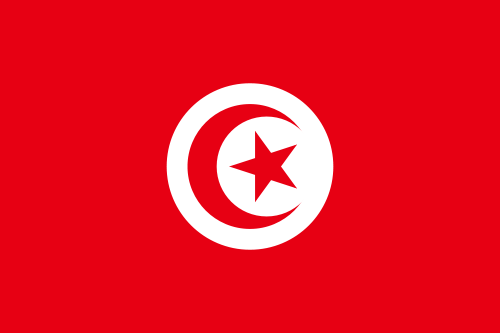
Country Flags by Continent
|
|
The Tunisian flag was defined in Article 4 of the 1 June 1959 constitution under these terms: "The flag of the Republic of Tunisia is red, it has, under the conditions defined by law, in the middle, a white circle containing a five-pointed star surrounded by a red crescent."
The Organic Law No. 99-56 of 30 June 1999, adopted on 3 July by the Chamber of Deputies, formalized the Tunisian flag for the first time in law, clarifying Article 4 of the constitution. The flag is in the form of a red rectangle with a width equal to two-thirds of its length. In the middle of the flag is a white circle whose diameter is equal to one-third of the length of the rectangle and whose center is located at the intersection of the diagonals of the rectangle. A red five-pointed star is located to the right of the circle, whose center is at a distance equal to one-thirtieth of the length of the flag from the center of the circle.
The location of the star's five points is determined by an imaginary circle centered around the star's center, its diameter equal to roughly 15% the length of the flag. The points of the star are equidistant from each other, and one of the points is located on the horizontal median of the flag to the left of the center of the imaginary circle. The star is surrounded on its left by a red crescent made by the intersection of two arcs, an outer arc whose diameter is equal to one-fourth of the length of the flag, and an internal arc with a diameter equal to one-fifth of the flag's length. In addition, at the top of the flag used by the President of the Republic, the words "for the nation" (Arabic: للوطن) are written in gold. The three outer edges of the flag are lined with golden yellow fringe and a red ribbon, with golden fringe on the right vertical side and a white disk with a star and crescent near the fringe, is attached to the flag pole above the flag.
Article 4 of the 1959 constitution specifies the presence of a technical dossier containing a model of the flag, a guide to drawing it, which includes the proper measurements, and technical specifications of its colors.
Symbolism
For the Tunisian embassy in France, the color red represents the blood of martyrs killed during the Turkish conquest of Tunisia in 1574. However, it is a well known historical fact that the Tunisan invited the Turkish to libirate them from the Spanish invaders and from what is left of the Hafside dynasity. Therefore, the interpretation of the Tunisian embassy is far from reality. Another interpretation is that the "red Beylical flag spread light throughout the Muslim world". The white symbolizes peace, while the crescent and five-pointed star represent unity of all Muslims and the Five Pillars of Islam, respectively.
According to Ludvík Mucha, author of Webster's Concise Encyclopedia of Flags & Coats of Arms, the white circle located in the center of the flag represents the sun. The red crescent and the five-pointed star, two ancient symbols of Islam, were most notably used on Ottoman flag and have since appeared on many flags of Islamic countries. The crescent is, from the viewpoint of an Arabic observer, supposed to bring good luck. The color red is a symbol of resistance against Turkish supremacy. Whitney Smith states that the crescent was first emblazoned on standards and buildings in the Punic state of Carthage, located in present-day Tunisia. Since appearing on the Ottoman flag, they were widely adopted by Muslim countries, and have become known as symbols of Islam, when in fact, they may be cultural symbols. |

